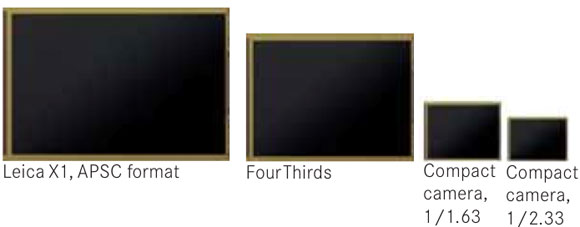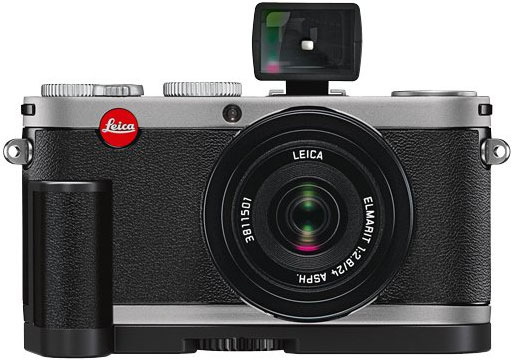
|

|

|

|

|

$220 SAVE $130 = 37.0% Western Digital 16.0TB Western Digital Ultrastar DC HC550 3.5-in… in Storage: Hard Drives
|

|

|

|

|
Leica X1 DSLR-quality Compact Camera
Related: depth of field, digital sensor, eyesight, Leica X, OVF, Panasonic, presbyopia
Shown below is the 12.2 megapixel Leica X1 compact camera with its optional optical viewfinder and handgrip.
At 337 grams (as weighed) with lens cap, battery and memory card, it’s the smallest and lightest APS-C sensor camera on the market, by far. By comparison, the Leica 24mm f/2.8 Elmarit-M ASPH for the Leica M9 weighs 375g by itself!
The handgrip is a nice plus, and I’d want it for sure, and it ought to be included, but it’s not. The viewfinder I could live without, because it bulks out the volume of the camera. But I’d still want it because it allows taking photos with the camera mashed against the forehead in low light, a major stabilizing factor that makes sharper images. And those of us hitting our later years have presbyopia too. Too bad the viewfinder alone costs more than a lot of point and shoots.
A camera, not a computer pretending to be a camera
I didn’t read the manual, and I figured the X1 out in 30 seconds. Kudos to Leica for usable design. I like dials and the right buttons, not lots of menus and tiny plastic buttons. Leica did it mostly right, (the dials should lock and perhaps one should be vertical just under finger, and the right control dial should be larger).
This is a camera, not a computer that tries to be a camera. I’ve not liked most point-and-shoot cameras for some time now, and this isn’t one of that sad genre. It’s a real camera with proper dials and controls, and that is its strength. And its the right size: one I’m willing to carry.
I took an immediate liking to the X1. While it has some disappointments and limitations, it’s a camera first. It doesn’t do video and it doesn’t do 10X zoom (or any zoom). As they say in Russia— tough shitsky— if you want to make quality images, less is more. If you want to be a dilettante, there are hundreds of alternatives. Though I’ll admit that if the X1 took interchangeable lenses, that would be a nice move— a sort of miniaturized M9. Mechanical manual focus with electronic assist would be a big improvement over crappy autofocus. So it’s not perfect.
The closest cameras to the X1 I’ve used are the Sigma DP-2, the Olympus E-P1, and the Panasonic G1 (all reviewed in DAP). I like the X1 better than all of them for the combination of build quality, menus/dials/controls, simplicity of operation, compactness.
Price and value
The X1 is no ordinary point-and-shoot, and the price makes that clear right away. But I’m not going to insert price into my assessment, a value judgment that befouls too many reviews. That’s your call. You do get a free copy of Adobe Lightroom with the X1, a ~ $300 value.
Sensor size
The X1 might be the camera I’ve wanted for a long time: “huge” sensor in a compact body. Linearly, the sensor is 2/3 the width and height of a 35mm full frame sensor (43% in area), huge for a point-and-shoot size camera. Since it is 2/3 the linear dimensions, its 24mm lens is equivalent to a 36.5mm lens (1.52 = 35.9 / 23.6) in terms of the field of view (“crop factor”) of a full-frame 35mm DSLR. Leica’s optional viewfinder is marked “36mm”.
Even a 4/3 format sensor camera looks small by comparison (18.0 X 13.5mm = 28% of full frame area). And the diminutive sensors of most compact cameras are tiny by comparison to either of those. The large sensor immediately showed its quality in my initial low-light test shots. Larger is better.
My immediate tests at ISO 800/1250/1600 were very impressive— this is one terrific sensor. It’s not just the noise, but the color and overall look of the image. I like it a lot, and I’m used to working with top-grade pro gear from Nikon, Canon and Leica. This sensor rules the compact class, no doubt there. For that matter, it looks as good as cameras like the Nikon D300s, and maybe I like it even better.
Sensor size is about more than quality, it also means you can make a pleasingly blurred background, a powerful tool. It also means that the look of the images the X1 makes is distinctly different from smaller sensor cameras eg much less depth of field.

Lens
The X1 has a 24mm f/2.8 lens, equivalent to a 36mm lens on full frame (1.52 = 35.9 / 23.6) . That’s a great choice in general, but it’s also the bad news: no other choices. On the other hand, zooms are over-rated, and the quality of the 24/2.8 looks to be very high from my quick initial testing.
One point of confusion with “by the numbers” tests you might find: it looks like there might be some rearward field curvature (very common) that makes the lens look less good that it is on planar (flat) test targets. Don’t be misled by lab MTF tests— they do have value if you know what to look for, but can also make outstanding lenses look average.
Stopping down beyond f/5.6 will drop the brilliance of the lens, so don’t needlessly stop down. Aperture f/8 is a good compromise between peak peformance and depth of field. By f/11, you’re throwing away the brilliance and peak performance, though gaining depth of field. Aperture f/16 should be avoided.
Up to 64TB @ 12500 MB/sec!
Mac or PC.
Ideal for Lightroom, Photoshop, 8K video, data analysis, etc.
Accessories, steady shooting, presbyopia
Adding the handgrip and optional viewfinder make the camera much more useful. My comments here based on direct experience with both.
The handgrip provides a far better grip, which not only helps prevent dropping it, but allows a better and firmer grip, for steadier pictures. This is not a camera I want to use a strap on, so a lanyard and the grip to me are absolutely essential.
The optional viewfinder means that a shake-free shooting technique can be used. Looking through the optical viewfinder, press the camera firmaly against the forehead, which couples the camera to gross whole-body movements (slow), not shaky hands. With proper usage, this can add a solid two shutter speeds eg 1/30 instead of 1/125, or even 1/15 with care and a few attempts. So that’s a big deal, and doing it well can even outperform overhyped image stabilization.
Without the viewfinder, one must hold the camera well away from the body, especially those of us with presbyopia (eg all middle aged and older people). Holding the camera out at arm’s length causes high frequency shaking and movement, a terrible way to take a sharp picture— low odds of success. Even higher speeds suffer from such bad technique (eg 1/125 second).
JPEG or RAW
Shoot RAW, or RAW+JPEG if you must. The X1 JPEGs are tolerable, but a waste of this camera.
Gripes
No camera is perfect. And what’s left out can sometimes improve function.
- Handgrip should be included.
- JPEGs just acceptable, to be avoided.
- Lanyard strap should be included (these are cheap, but the omission is irritating).
- LCD display ought to have double the resolution.
- No video.
- Autofocus is crappy, like almost every other point and shoot camera.
- Overall operation is a bit slow (playback, on/off, etc).
- Stupid: no option to turn off JPEG and just shoot pure RAW.
- Optional optical viewfinder is expensive.
- No interchangeable lenses, no zoom.
- Maximum aperture of f/2.8 is limiting for low light (f/2 would have been nice).
- Price is daunting for most people.
Conclusions
The X1 provides DLSR quality in a compact body, a rare, perhaps even unique combination. That’s awesome, and it’s an outstanding camera for the right kind of photographer.
It’s the combination of features: that I like: build quality, size, image quality, etc. It’s a winning combination. Compare to cameras like the Panasonic G1 or Canon G11 or Olympus E-P1 or Sigma DP-2, and that’s fine, but the Leica X1 really has no competition in terms of its gestalt. Whether it suits you depends on your tastes, but having owned way too many point and shoots that gather dust, the X1 is one camera I don’t think I’d tire of.
Going on a backpacking trip? This is the camera for high quality and one you won’t resent having carried. The lack of a zoom just means you can take better pictures— not every picture you might want, but really good ones that you had to compose, not just snap (“foot zoom”). And good ones at dusk or around the camp stove.
Versus the Panasonic GF1
Lots of folks like the Panasonic GF1. But it’s not at all the same type of camera, the X1 is pocketable, the GF1 is not, and the GF1 feels... cheap. Which isn’t totally fair, but that’s the way it is for me. On the other hand, people shooting kids or quick grab shots or who want more lens choices are going to like the GF1 better. But the X1 is a more traditional camera, a more thoughtful camera. What’s better is a personal choice, and there’s no law against owning more than one camera. The bottom line is which camera will get carried and thus used. My wife would carry the X1, because it fits into her purse. She won’t carry the GF1— end of story! Even the Olympus E-P1 is too big. I know I would take the X1 far more than the GF1, because the GF1 feels like a DSLR, albeit a small one, and if I’m in that arena, I’ll just take the Beast.
Seagate 22TB IronWolf Pro 7200 rpm SATA III 3.5" Internal NAS HDD (CMR)
SAVE $100


















